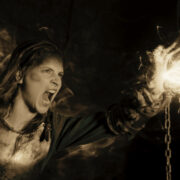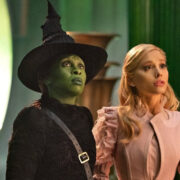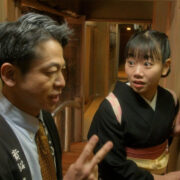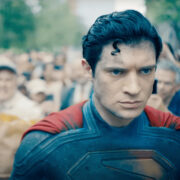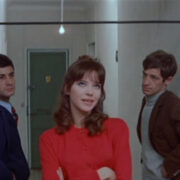THE FILMS OF JOAQUIM PEDRO DE ANDRADE: A Challenging, Heterogenous Career Made Available

Midwesterner, movie lover, cinnamon enthusiast.
“I have everything I don’t want, and I have nothing I want.”
These are the first words of the cinema of Joaquim Pedro de Andrade, prominent figure of the Brazilian new wave movement, Cinema Novo. It’s an appropriate opening to a cinema of frustration and sundry diversions, which can now be viewed in its beautiful, 2K restored entirety thanks to Kino Lorber.
Perhaps the most obvious conflict in this 23-year career, made blindingly clear with this new three-disc collection, is a near-constant formal unrest that dictates the director’s complete filmography. Preoccupations (class and sex) and tendencies (Brazilian artists of note) reveal themselves, and you can make little groups of similarity within the catalogue – but overall, the 16 films of de Andrade’s output show an uncommonly heterogeneous body of work.
When you go chronologically through his eight shorts and six features, as I did, you quickly learn to abandon expectations. There are abrasive switches in tone — perhaps none more startling than the opening of his first feature-length fiction, Macunaíma — and aesthetic that, as Fábio Andrade states in the appended essay, simultaneously challenge and reinforce traditional notions of the auteur.
In short, de Andrade, who was born in an intellectual household (his father founded Rio de Janeiro’s Institute for National Artistic and Historical Heritage), started his career with gentle profiles of a day in the life of artists and ended it with a nude revolutionary woman ripping off a man’s hard-on only to bear it herself.
The Early Works
It starts in 1959 with The Poet of Castelo and The Master of Apipucos, both miniature portraits of accomplished men — the former of poet (and de Andrade’s godfather) Manuel Bandeira and the latter of sociologist Gilberto Freyre. They each have a diary type framework, with The Poet of Castelo prospering from a looser visual and structural style. However, both contain frequently beautiful shots that showcase de Andrade’s eye for both natural and urban beauty.
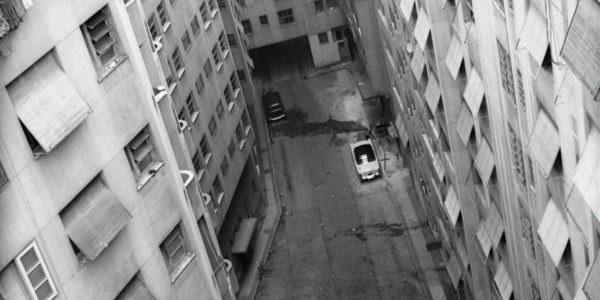
Michael Talbott points out perhaps the first important tension of de Andrade’s oeuvre when, for Senses of Cinema, he notices that the only black person in The Master of Apipucos is Freyre’s servant, appearing only to serve him dinner, despite the sociologist penning the seminal work The Masters and the Slaves. In light of such a fact, de Andrade’s use of “Master” in the film’s title significantly changes the viewer’s perspective.
De Andrade’s third work, the short Cat Skin, while presented here on its own, was also hemmed into Favela Five Times — an anthology film of favela life in Rio de Janeiro. While the short mixes documentary and fiction footage, it plays completely fictionalized, with calculated matching shots and well-framed interactions.
This is de Andrade’s first complex work. While the preceding shorts shouldn’t be ignored, there’s a narrative depth on display here. He shows an understanding of montage and emotional maturity that maintains the buoyant tone of his previous shorts, while graphing on the broader implications of the Italian neorealist films of the preceding decade. In this way, it’s actually not dissimilar from the debut of his European contemporary, Francois Truffaut’s The 400 Blows, which came out just three years prior. (It’s also worth noting, considering the palpable influence here, that just before starting his film career, de Andrade had interviewed Roberto Rossellini, Italian neorealist dignitary.)
Cat Skin’s ending is what particularly makes it not only de Andrade’s first mature work, but also one of his best. The film’s pre-pubescent protagonist, who has spent the short in search of village cats to sell for the production of tambourine skins, recognizes the inherent treasure of other lives once he looks in a cat’s eye and offers it a bite of his food. Even in his twenties, de Andrade refrains from visually waxing sentimental. It’s a quick moment, but it lives on in his catalogue.
De Andrade continued his reputation for profiling successful men with his first feature-length film, Garrincha: Joy of the People — a 60-minute documentary about Brazilian soccer player (and teammate of Pelé). The film appears to be a fairly straightforward account of his skills and contributions to Brazil’s World Cup performances in 1958 and 1962.
De Andrade finishes the film poignantly, contextualizing everything we’ve seen of Garrincha within the scope of Brazil’s mass culture, by visually articulating the national significance of such a player and sport. As we watch a stadium vacate, post-celebration, we’re left with empty images that suggest the emotional and spiritual void left in the national consciousness when the match is over.
Like many of de Andrade’s films, Garrincha was an assignment, and one he reportedly used to employ some of his Cinema Novo brethren. A few years later, he would turn his profiles inward with a short documentary explicitly about this Brazilian new wave cinema, aptly titled Cinema Novo, or perhaps Improvised and Purposeful elsewhere. It’s a plainspoken how-the-sausage-is-made document whose most interesting bits are being able to watch filmmakers ask successful businessmen for money.
The film ends with a narration of the following Cinema Novo credo: “A new cinema faces the people. This encounter, still provocative, is sought through films that try to explore Brazilian reality, to confront an audience that’s been shaped by conventional movies for years. Marked by its time, this young Brazilian cinema is necessarily controversial. The fight has just begun.” Revisiting this edict after having finished de Andrade’s filmography is quaint for its unbelievably accurate forecast (with regards to de Andrade).
The Color Works
His following work, and first in color, Brasilia: Contradictions of a New City, is another in the column of commissions (this one by the company Olivetti) and thus doesn’t quite fulfill the movement’s decree, but it’s no less important a part of de Andrade’s oeuvre. It’s a short piece about Brasilia, a new Brazilian city poised as a utopia of urban design, which de Andrade makes a compelling (and visually lush) case against by presenting the consequential lives of the nearby laboring class.
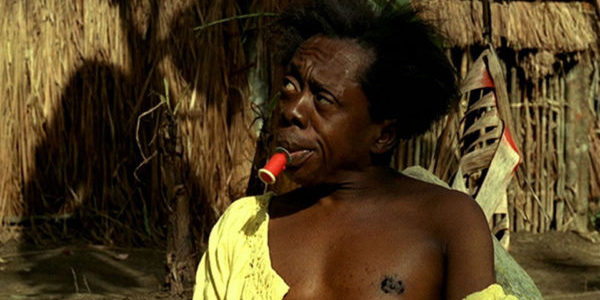
The film is shot in constant tracking shots that sweep across the city’s pristine constructions, which are bitterly offset not only with aforementioned interviews of the proletariat class, but with a memorable voiceover that caps the film:
“Brasilia was the great opportunity offered to Brazilian architecture: a whole city to be designed from the start according to the most modern techniques of urban design and with absolute creative freedom. When it expels from its bosom the humble men who built it and those who are yet to come, Brasilia embodies the basic conflict of Brazilian art, beyond the reach of the majority of people.”
He goes on to say that these are problems in every Brazilian city, but in Brasilia, “they are revealed with unbearable clarity.” It’s a film that seems to be a clear influence on Gary Hustwit’s 2011 documentary Urbanized.
What follows Brasilia in de Andrade’s filmography is, as previously stated, one of the most startling and abrasive career shifts. Macunaíma opens with a white woman in the jungle giving standing birth to a full grown black son. This blunt moment of de Andrade’s 1969 feature marks a full-body stylistic pivot from what came before, eschewing European cinematic touchstones in favor of carving out something new and confrontational.
Because of this pivot, I think it’s fair to say that viewer’s mileage may vary with de Andrade’s work from 1969 forward. Like it does in time, Macunaíma also takes place on a formal spectrum between The Monkee’s Head and Lina Wertmüller’s The Seduction of Mimi. It’s a wild, horny film that plainly bears the indulges of its historical residence: fluid identity, omnivorous sexuality, political revolution, etc.
It’s too simple to say the rest of his fictional output is of the same ilk, because with any other director, each film would mark a considerable shift. While The Conspirators and Conjugal Warfare are wildly different works, they both exhibit a critical artist preoccupied with themes first introduced in Macunaíma. But the rest of his work (outside his short documentary profiling architect Antonio Francisco Lisboa) can simultaneously be filed under the pop art movement called Tropicalism, and how you react to Macunaíma will most likely be a good barometer for how much you enjoy what follows.
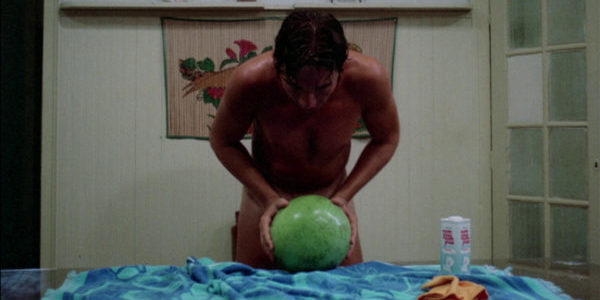
That said, de Andrade doesn’t lose his vigor, but rather finds new ways to confront his viewership. In other words, a traditional sense of enjoyment is bypassed by a sense of curiosity, both historically and narratively. Take, for instance, the 1977 short Tropical Paths,about a professor who f*cks fruit (40 years prior to Call Me By Your Name). He spends his free time buying, cleaning and courting watermelons before penetrating them. Through a relationship with his student, who he persuades to find her own applicable produce, de Andrade reveals an unusually beautiful and sexually transgressive film.
The Films of Joaquim Pedro de Andrade: Conclusion
By the third act of de Andrade’s career, you learn to abandon your previously calibrated sense of film viewing. When the protagonist (Brazilian poet Oswald de Andrade) of his swan song, The Brazilwood Man, is played concurrently by both a man and woman, often in conversation with each other, you’ve most likely already given yourself over to whatever de Andrade is offering. Thankfully, what’s on the menu is almost as commonly beautiful as it is frustrating. I’m not sure I can claim that de Andrade’s filmography is home to a masterpiece, but at the same time, it’s such a singular body of work that it hardly matters.
Additionally, your understanding of de Andrade’s work will undoubtedly be affected by your understanding of Brazilian history. In that regard, the set from Kino Lorber lacks supplemental materials that would help contextualize these 16 films within a broader historical tapestry, but I’m not one to look a gift horse in the mouth, and what Kino Lorber has given us with this new collection is truly a gift.
The Films of Joaquim Pedro de Andrade collection is now available on Blu-ray from Kino Lorber.
Does content like this matter to you?
Become a Member and support film journalism. Unlock access to all of Film Inquiry`s great articles. Join a community of like-minded readers who are passionate about cinema - get access to our private members Network, give back to independent filmmakers, and more.


